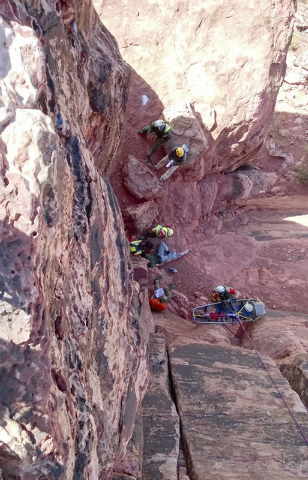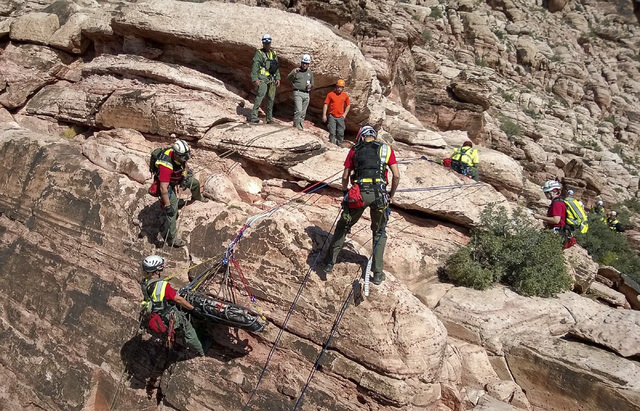Rock climber grateful for save by Metro’s search and rescue team
Time moved strangely for David Sampson as he lay on the rocks with cracked ribs, a punctured lung, a dislocated finger, a broken foot and a cracked climbing helmet.
A helicopter hovered overhead. A Metro search and rescue officer descended on a cable. He placed Sampson in a basket, and the helicopter flew them both to a safe area. The two men dangled 100 feet below the chopper in a maneuver called a short haul.
Sampson fell 30 feet during a Memorial Day climb at Red Rock Canyon National Conservation Area. At more than 400 feet above ground, his climbing partners had to lower him to a more secure location before calling for help.
In a hangar at the North Las Vegas Airport, Sgt. Nate Anderson of Metro’s search and rescue unit got the call about Sampson from dispatch. He and several other search and rescue officers suited up, got into a unit helicopter and headed to Red Rock.
While some officers set up a medical station on Red Rock’s scenic loop, others climbed to Sampson and helped move him to a spot more accessible by helicopter.
Sampson’s rescue was one of five that weekend. It came just before Metro Search and Rescue was re-accredited by the Mountain Rescue Association, which it has been associated with since 1994.
Metro Search and Rescue covers all of Clark County and responds to about 150 calls a year. They also take part in SWAT missions as medical backup about 400 times a year. Team members rescue lost campers and injured hikers and are called to recover bodies and crime scene evidence from Lake Mead, where each dive is filmed with waterproof cameras.
Just seven full-time rescuers and a few dozen volunteers manage all of those responses.
Anderson has been the unit’s sergeant for just over a month. He’s been with Metro for 22 years and considered becoming a SWAT officer before the rescue team position opened up.
“I lucked out,” Anderson said.
Generally, because of the competitiveness of the field and the appeal of the job, there’s little turnover on the search and rescue team.
Spots as unpaid volunteers also are competitive.
The team includes about 20 mountain rescue volunteers, seven to eight divers and 14 SWAT doctors. The number of applications for volunteer positions submitted as of July is close to 200, and the requirements are demanding.
Volunteers must be certified EMTs at the time they apply. When a position opens, 10 to 15 candidates are selected and have to go through a basics class, which takes up to six months. The chosen finalist then has to pass a physical fitness test every six months to remain a volunteer.
Monthly classes and training are mandatory for team members. Some involve realistic scenarios at Red Rock, Lake Mead or Mount Charleston. Others are offered at the search and rescue unit’s headquarters at the North Las Vegas Airport, which houses the unit’s rescue boats and four helicopters, all decommissioned from the military.
The helicopters are used on almost all responses, and the team has to be proficient in using the hoists, cables and winches aboard. One maneuver that makes some officers anxious is fast-roping: tossing the end of a cable out the helicopter door and sliding down it, fire-pole style.
“Adrenaline and logic: there’s both in every rescue,” said Officer John Thayer, who helped rescue Sampson. “Each officer has his own process, and we all know each other’s. You can’t wing it.”
On free days, the team attends career days or safety fairs at elementary schools throughout the valley. Christmas cards come in the mail for officers from people they rescued years ago.
“The people we work with aren’t criminals,” Thayer said. “They are people who wanted to have fun, and might not have made it without our help.”
Sampson, a climber of two decades and research scientist for Arizona State University, is on the mend back home in Tempe, Ariz. He hopes to be climbing again by November.
His eyesight, which temporarily was damaged from the concussion he sustained in the fall, is back to normal. He has a screw in his foot and wears a brace while it heals. His ribs and lung, which he said were the most painful and scary parts at the time, are getting better.
“I just wasn’t respecting the climb as much as I should have,” Sampson said Wednesday of the fall. “It’s rarely one thing that goes wrong. It’s always a combination.”
The only thing that worries him about returning to climbing is that his left pinkie, which was dislocated, remains quite painful.
He acknowledges the fact that he was in very real danger that Saturday afternoon in Red Rock, and might not have made it without help from Metro’s rescue personnel.
“They were all very professional, very friendly, very personable,” Sampson said of the team during his rescue, which was the 43rd of the year. “My whole experience with them was just stellar.”
Contact Annalise Little at alittle@reviewjournal.com or 702-383-0391.



















